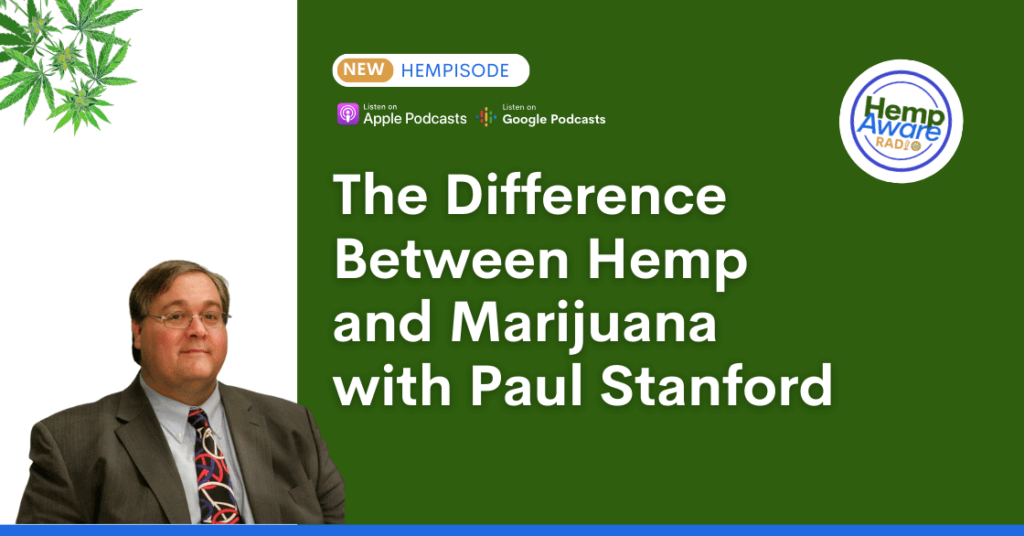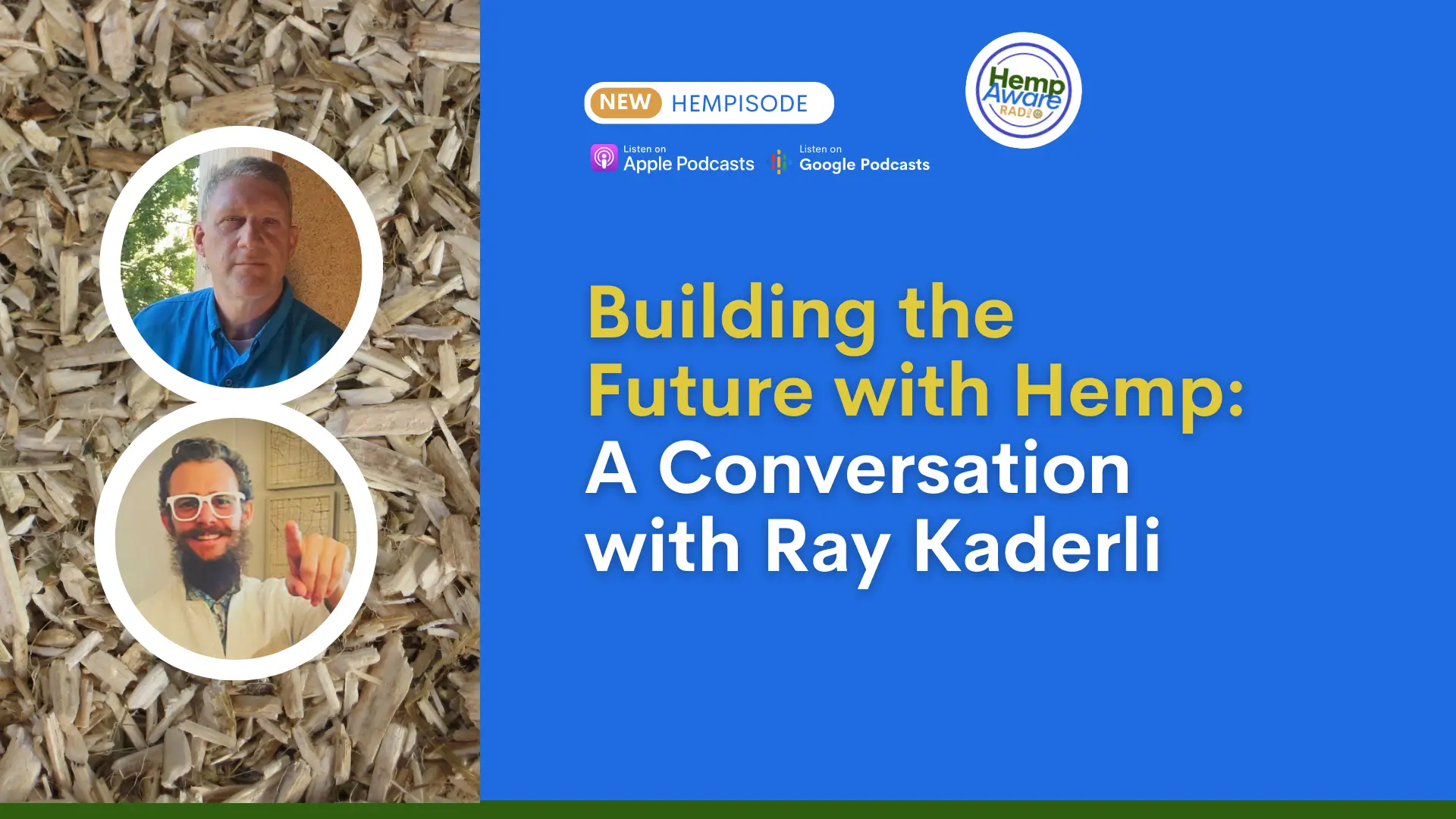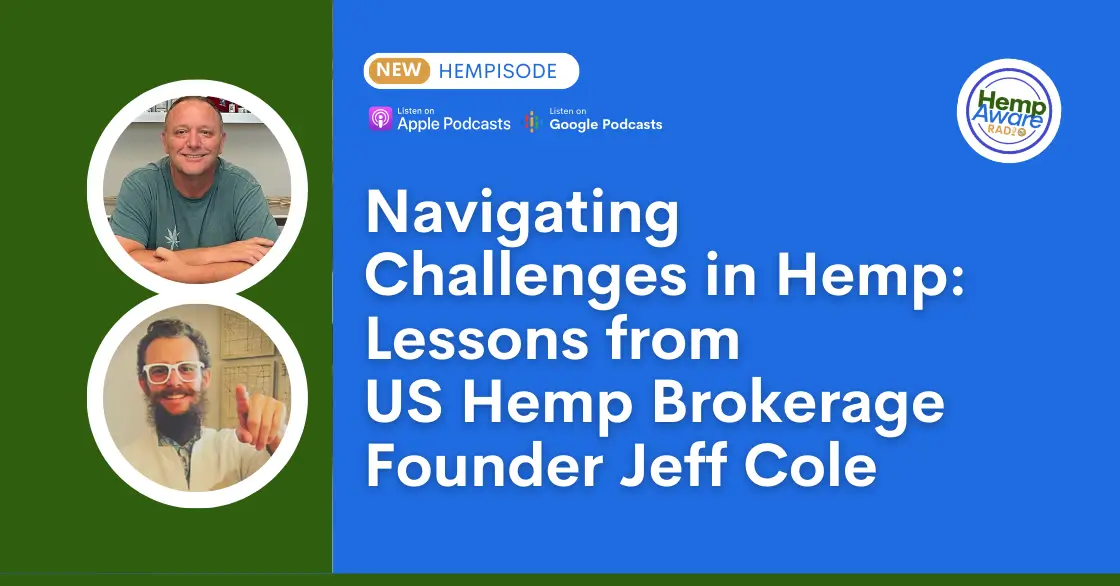In this blog post, we will explore some of the fascinating facts and discussions covered in the show, shedding light on the versatility and on this hempisode we dive into the rich history and main difference between hemp and marijuana.
HempAware Radio, hosted by Tyler Hemp, is a global podcast that delves into the world of hemp and its various uses.
A Warm Welcome to Paul Stanford to help Understand the Difference Between Hemp and Marijuana
On the day of the show, Tyler eagerly awaited Paul’s arrival. As soon as Paul walked through the studio doors, Tyler could sense his passion and knowledge about all things hemp.
“Welcome, Paul!” Tyler exclaimed enthusiastically, extending a hand for a firm handshake. “It’s an honor to have you here on HempAware Radio.”
Paul smiled warmly and nodded at Tyler. “Thank you for having me, Tyler. It’s a pleasure to finally meet you and be a part of this amazing show.”
The two men settled into their chairs, ready to dive into a conversation that would capture the hearts and minds of their listeners.
As the show began, Tyler guided the discussion, allowing Paul to share his journey with hemp and how it led to the creation of the Hempstock Festival.
Hemp: A Crop with a Rich History
Hemp is not only one of the most widely grown crops in human history, but it is also one of the most versatile.
It has been cultivated for thousands of years and has served various purposes, from being used as a fuel source to being woven into fabrics.
In fact, it is believed to be one of the first crops cultivated by humans.
The history of hemp dates back to ancient times, with evidence of its cultivation found in many regions around the world.
The plant is thought to have originated in Central Asia, where it thrived in the fertile soil and temperate climate. As early as 10,000 years ago, humans began cultivating hemp for its fibers and seeds.
One of the earliest uses of hemp was for making textiles. The fibers from the plant’s stalks were harvested and spun into thread, which was then woven into fabrics.
Hemp cloth was highly valued for its strength and durability, and it was used to make clothing, ropes, and sails for boats.
In fact, the word “canvas” is derived from the Latin word “cannabis,” which is the scientific name for hemp.
Hemp was also used as a source of fuel. The plant’s woody core, known as the hurd, could be burned to produce heat and light.
This made hemp an important energy source for early civilizations, especially in areas where other sources of fuel were scarce.
The use of hemp as a fuel source continued for many centuries, even after the discovery of fossil fuels.
In addition to its practical uses, hemp also played a significant role in religious and cultural ceremonies.
Many ancient civilizations revered the plant for its medicinal properties and believed it had spiritual significance.
Hemp was used in rituals and as offerings to deities, and it was thought to bring good luck and protection.
As civilizations expanded and trade routes were established, hemp spread throughout the world.
It was grown in ancient China, where it was used to make paper, and in ancient Egypt, where it was used in the mummification process.
The plant made its way to Europe and was grown extensively during the Middle Ages. Hemp cultivation was so important in Europe that laws were enacted to ensure its production.
During the age of exploration, hemp played a crucial role in maritime trade.
The strong fibers of hemp rope made it ideal for use in ships’ rigging, and the oil extracted from hemp seeds was used to lubricate the wooden hulls.
Without hemp, the exploration and colonization of the New World would have been much more difficult.
However, with the industrial revolution came new technologies and materials, and hemp began to decline in popularity.
Synthetic fibers and petroleum-based products replaced hemp in many industries. In the early 20th century, the cultivation of hemp was heavily restricted and even prohibited in some countries.
Fortunately, in recent years, there has been a resurgence of interest in hemp. The recognition of its environmental benefits and its potential as a sustainable resource has led to the legalization of hemp cultivation in many regions.
Today, hemp is being used to create biofuels, construction materials, and biodegradable plastics.
It is also being explored for its potential in medicine, with compounds derived from hemp showing promise in treating various conditions.
The rich history of hemp is a testament to its value and resilience as a crop.
From its humble beginnings as a source of fiber and fuel to its potential as a solution to modern challenges, hemp continues to be an important plant in human civilization.
The Different Varieties of Hemp & Cannabis
In the world of cannabis, there is a common misconception that it is a single genus. However, this could not be further from the truth.
Cannabis actually has various different varieties, each with its own unique characteristics and uses.
The key factor that sets these varieties apart is the legal definition of cannabis, which varies from country to country.
This distinction is often made for political purposes, but at its core, it should be understood that all these varieties come from the same plant.
So, what are these different varieties? Let’s take a closer look:
Sativa
Sativa is one of the most popular varieties of cannabis.
It is known for its tall and slender structure, with long leaves and thin branches. Sativa plants thrive in warm climates and can grow to impressive heights.
The effects of sativa strains are typically energizing and uplifting, making them a great choice for daytime use. Sativa can be found in various forms, including dried flowers, concentrates, and edibles.
Indica
Indica is another well-known variety of cannabis. Unlike sativa, indica plants are generally shorter and bushier, with wide leaves and dense buds.
They are typically grown in cooler climates and have a faster flowering time compared to sativa. Indica strains are known for their relaxing and sedating effects, making them ideal for evening or nighttime use.
Just like sativa, indica can be consumed in different forms, depending on personal preference.
Hybrid
Hybrid strains are a result of crossbreeding sativa and indica plants. The goal of hybridization is to create a cannabis variety that combines the desirable traits of both sativa and indica.
This can include a balance of uplifting and relaxing effects, as well as an appealing flavor and aroma profile.
Hybrid strains can vary widely in their characteristics, depending on the specific genetics involved. It is not uncommon to find hybrid strains with dominant sativa or indica traits.
Hemp’s Medicinal and Nutritional Benefits
Hemp is a plant that has been cultivated for thousands of years, and its benefits extend far beyond being used as a textile and food source.
In fact, hemp has been used for medicinal purposes both topically and internally since ancient times.
Today, scientific research continues to uncover the many ways in which hemp can support our health and well-being.
Topical Use of Hemp
One of the most well-known uses of hemp is in skincare products.
Hemp oil, derived from the seeds of the plant, is rich in essential fatty acids, vitamins, and antioxidants.
These nutrients have been found to nourish and hydrate the skin, helping to maintain its elasticity and youthful appearance.
Furthermore, hemp oil has anti-inflammatory properties that can reduce redness, irritation, and inflammation associated with various skin conditions, such as acne, eczema, and psoriasis.
It penetrates deep into the pores, promoting cell regeneration and providing relief from dryness and itchiness.
Hemp-based creams and lotions are also effective in soothing muscle and joint pain.
The anti-inflammatory properties of hemp can help reduce swelling and discomfort, making it an excellent natural remedy for arthritis, sprains, and strains.
Many athletes and fitness enthusiasts have turned to hemp-based topicals for their post-workout recovery.
Internal Use of Hemp
Beyond topical applications, hemp seeds are a nutritious addition to any diet. They are a complete source of protein, containing all the essential amino acids our bodies need.
This makes hemp an excellent plant-based protein option for vegetarians, vegans, or anyone looking to increase their protein intake.
In addition to protein, hemp seeds are rich in healthy fats, including omega-3 and omega-6 fatty acids. These fats play a crucial role in brain function, cardiovascular health, and reducing inflammation.
By incorporating hemp seeds into your daily diet, you can naturally support your overall well-being.
What’s more, hemp seeds are a great source of vitamins and minerals.
They are particularly high in vitamin E, which is known for its antioxidant properties. Vitamin E helps protect our cells from damage caused by free radicals, which can lead to chronic diseases and premature aging.
Hemp in the Kitchen
Aside from its medicinal and nutritional benefits, hemp can also be enjoyed in various culinary ways. Hemp seeds have a mild, nutty flavor that adds depth and richness to any dish.
They can be sprinkled over salads, incorporated into smoothies, or used as a topping for yogurt or oatmeal.
You can also find hemp-based milk, which is a dairy-free and plant-based alternative.
Hemp milk is creamy and delicious, making it a perfect addition to coffee, cereals, or baked goods.
It is a great choice for individuals who are lactose intolerant, allergic to nuts, or follow a vegan lifestyle.
Additionally, hemp oil can be used in dressings, dips, and marinades, adding a unique flavor profile to your favorite recipes.
It is important to note that hemp oil should not be used for high-heat cooking, as it has a low smoke point. Instead, it is best enjoyed in raw or low-heat applications.
The Role of Cannabis in Medicine
In today’s modern world, discussions surrounding the use of cannabis in medicine have become increasingly prominent.
However, what many people may not realize is that the history of cannabis in medicine dates back centuries.
Throughout the ages, cannabis has played a significant role in providing relief to individuals suffering from various ailments. Its medicinal properties have been recognized and utilized by different cultures around the world, making it an integral part of our medical heritage.
Cannabis, also known as marijuana, has been embedded in the fabric of humanity due to its numerous therapeutic benefits.
The plant contains over one hundred chemical compounds known as cannabinoids, with the two most notable being tetrahydrocannabinol (THC) and cannabidiol (CBD).
These cannabinoids interact with the body’s endocannabinoid system, which is responsible for maintaining homeostasis and regulating various bodily functions.
Historically, cannabis has been used in traditional medicine for its analgesic and anti-inflammatory properties. Ancient civilizations, such as the Egyptians, Greeks, and Chinese, recognized its potential as an herbal remedy.
For example, the Ebers Papyrus, an ancient Egyptian medical text dating back to 1550 BCE, mentions the use of cannabis for treating various conditions, including inflammation and glaucoma.
In more recent times, the pharmaceutical industry has also explored the medicinal potential of cannabis.
The United States government, for instance, holds a patent (US6630507B1) on the use of cannabis for treating eye cancer and pain.
This patent highlights the recognition of cannabis as a legitimate medical treatment by a governing body, further solidifying its role in modern medicine.
One of the most well-known applications of cannabis in medicine is its ability to alleviate pain and provide relief to individuals suffering from chronic conditions.
For patients with conditions such as multiple sclerosis, arthritis, or cancer, cannabis can play a vital role in managing pain and improving their quality of life.
The analgesic properties of cannabinoids make them effective in reducing pain and inflammation, allowing patients to find relief without relying solely on traditional pain medications.
In addition to pain management, cannabis has also shown promise in the treatment of various neurological disorders.
Research suggests that cannabinoids can help regulate and protect brain function, making them beneficial for individuals with conditions like epilepsy, Alzheimer’s disease, and Parkinson’s disease. Furthermore, cannabis has been found to have neuroprotective properties, meaning it may help slow down the progression of certain neurological disorders and protect brain cells from damage.
Beyond its analgesic and neurological applications, cannabis has also proven effective in managing mental health conditions.
Patients with anxiety, depression, and post-traumatic stress disorder (PTSD) have reported positive effects from using cannabis as part of their treatment regimen.
The calming and mood-stabilizing properties of cannabinoids can help alleviate symptoms and improve overall mental well-being.
Furthermore, cannabis has demonstrated potential in the field of oncology. Studies have shown that cannabinoids, particularly CBD, may have anti-cancer properties and can inhibit the growth of tumor cells.
Additionally, cannabis can help alleviate the side effects of cancer treatments such as chemotherapy, including nausea, vomiting, and loss of appetite.
The ability of cannabis to provide relief and support to cancer patients has made it a valuable complementary treatment option in the field of oncology.
In conclusion, cannabis has a long and storied history in medicine.
From ancient civilizations to modern pharmaceutical advancements, its therapeutic properties have been recognized and harnessed for centuries.
Whether it’s providing pain relief, managing neurological disorders, improving mental health, or supporting cancer treatment, cannabis continues to play a significant role in the field of medicine. As research and understanding surrounding this versatile plant continue to evolve, we can expect its medicinal applications to expand, further solidifying its place in the realm of healthcare.
The Productivity and Potential of Hemp
Once upon a time, in a small village surrounded by lush green fields, there lived a farmer named John.
John was known for his innovative farming practices and his dedication to cultivating crops that were not only productive but also sustainable.
He had heard about a miracle plant called hemp, which had been growing for thousands of years and had a wealth of potential.
One sunny morning, as John was tending to his fields, he stumbled upon an ancient scroll hidden deep within the soil.
Curiosity piqued, he unraveled the scroll and discovered that it contained valuable information about the productivity and potential of hemp.
Ancient Origins of Hemp & Cannabis
John learned that hemp had been grown for centuries and was indeed the oldest agricultural crop known to humanity. Its history could be traced back to ancient civilizations such as the Egyptians, who used it to create ropes, textiles, and paper.
He marveled at the fact that this versatile plant had been cultivated for so long, even in times when modern technology was but a distant dream.
Hemp is a Highly Productive Crop
What intrigued John the most was the remarkable productivity of hemp.
He discovered that hemp could produce more fuel from its seed oil compared to other crops, making it an efficient and sustainable option.
This meant that hemp had the potential to not only meet the demand for renewable energy but also reduce our dependence on fossil fuels.
With excitement brimming in his eyes, John envisioned a future where hemp-powered vehicles would roam the streets, significantly reducing carbon emissions and contributing to a healthier planet.
He imagined a world where sustainable fuel was not just a dream but a reality, thanks to the productivity of hemp.
A Shifting Public Opinion on Hemp & Cannabis
As John delved deeper into his research, he stumbled upon recent polls that reflected a significant swing in public opinion towards hemp.
He realized that people were becoming more aware of the possibilities and benefits of this versatile plant.
From textile manufacturers to paper mills, there was a growing interest in incorporating hemp into their production processes.
John was ecstatic to learn that hemp had the potential to not only revolutionize the fuel industry but also have a positive impact on various sectors.
He envisioned hemp-based textiles that were not only durable but also eco-friendly, taking the fashion industry by storm.
He dreamed of books, magazines, and newspapers made from hemp paper, reducing deforestation and preserving our precious forests.
A Promising Future for Hemp & Cannabis
With a newfound passion, John dedicated himself to growing hemp on his farm.
He believed that it was not just an agricultural crop but a symbol of hope for a sustainable future.
He spread the word about the productivity and potential of hemp, inspiring fellow farmers to embrace this versatile plant.
“Hemp is not just a plant. It is a game-changer that can transform industries and revolutionize our lives.”
John’s love for hemp was contagious.
Soon, neighboring villages started cultivating hemp, opening doors to a world of endless possibilities.
The once-skeptical public began to see the immense value of this crop, its ability to regenerate soils, its low water requirements, and its versatility.
As the sun sets on John’s productive hemp field, we are reminded of the untapped potential that lies within this ancient crop. With growing interest and shifting public opinion, the future looks bright for hemp, paving the way for a sustainable and efficient tomorrow.
And so, the story of John and his beloved hemp continues to inspire farmers, innovators, and dreamers alike, igniting a passion for change and a commitment to harnessing the productivity and potential of this remarkable plant.
Tyler Hemp & Paul Stanford: A Dynamic Convo
Once upon a time in the vibrant city of Portland, Oregon, the air was filled with the sweet scent of hemp and the sound of laughter.
It was the day that Tyler Hemp, the charismatic host of Hemp Radio, was about to welcome a very special guest to his show.
Tyler, a true cannabis connoisseur, dedicated his radio show to exploring the endless possibilities and benefits of hemp.
He regularly brought in experts and enthusiasts from all corners of the industry to educate and entertain his listeners. And today was no exception.
The Hempstock Festival
As Tyler prepared for the show, he couldn’t help but think about the upcoming Hempstock Festival.
It was an event that celebrated all things hemp, from its rich history to its innovative uses in the modern world. And the man behind it all was none other than Paul Stanford.
Paul Stanford, an advocate for hemp and its legalization, had worked tirelessly to promote its benefits and destigmatize its use.
The Hempstock Festival was his brainchild, a gathering of like-minded individuals who believed in the power of hemp to transform lives, industries, and the environment.
Through his show, Tyler had heard about the festival, but he had never met Paul in person.
So, when he got the chance to invite Paul as a guest on Hemp Radio, Tyler jumped at the opportunity.
A Shared Vision Around Hemp
Throughout the interview, it became clear that Tyler and Paul had a shared vision. They both believed in the power of hemp to heal the planet and improve lives. They also, both clearly understand the difference between hemp and marijuana.
“Hemp is not just a plant,” Paul passionately explained. “It’s a solution. It can be used for sustainable agriculture, eco-friendly building materials, nutritious food, and even as a source for renewable energy. The potential is limitless.”
Tyler nodded in agreement, absorbing every word Paul spoke. The conversation flowed effortlessly, with Tyler asking insightful questions and Paul providing thought-provoking answers.
The chemistry between them was undeniable. Their shared passion for hemp created a dynamic energy that resonated through the radio waves and touched the hearts of their listeners.

In Conclusion: Difference Between Hemp and Marijuana
A Grateful Host
As the interview came to an end, Tyler couldn’t help but express his gratitude to Paul.
“Paul, I want to thank you from the bottom of my heart for being on HempAware Radio today,” Tyler said sincerely. “Your knowledge, passion, and dedication to hemp are truly inspiring.”
Paul smiled, his eyes sparkling with appreciation. “Thank you, Tyler. It’s been an absolute pleasure. I can’t wait to see what the future holds as we continue to spread awareness about the incredible potential of hemp.”
Tyler wrapped up the show, already looking forward to the next time Paul would join him on HempAware Radio. Together, they were a dynamic duo, united in their mission to educate and empower others through their love for hemp.
And as their voices echoed through the airwaves, they left their listeners inspired and eager to explore the world of hemp, armed with newfound knowledge and a sense of hope for a greener, brighter future.







